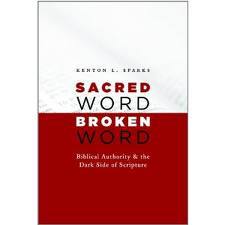 This is the third post (see first and second) on Sparks’s most recent book Sacred Word, Broken Word: Biblical Authority and the Dark Side of Scripture
This is the third post (see first and second) on Sparks’s most recent book Sacred Word, Broken Word: Biblical Authority and the Dark Side of Scripture. In chapter 3, he looks briefly with how a proper, biblical view of Christ (Christology) can help us look at Scripture more realistically.
His main point is this: Jesus was really a human being, who “lived out his life within a finite human horizon” (p. 24). This has implications for how we look at the Bible. Drawing a connection between how we understand Christ and the Bible is sometimes referred to as the Christological analogy of Scripture, which, as many of you know, is the central focus of my own book Inspiration and Incarnation: Evangelicals and the Problem of the Old Testament
central focus of my own book Inspiration and Incarnation: Evangelicals and the Problem of the Old Testament.
Citing some early Church Fathers, Sparks asserts that Jesus did not fake being fully human. He really was, and that necessarily means he was limited in his humanity. Part of that limitation, Spraks argues, is that Jesus necessarily participated in our fallen nature, though without sinning. (See Romans 8:3-4, where Paul says that God sent Jesus “in the likeness of sinful flesh.” Also, Jesus was made like us in every way, as in Hebrews 2:17 and 4:15.)
It was necessary for Christ to take on the fallen human condition in order to redeem it. “Fallen creation is redeemed only when God participates in fallen creation” (p. 27).
The upshot of all this is summarized in Sparks’s citation of I. Howard Marshall and Colin Gunton. Marshall, speaking of Jesus’ references to hell in his parables, says that Jesus employs imagery “belonging to the time in society that was accustomed to such things” (see Marshall Beyond the Bible: Moving from Scripture to Theology pp. 66-69, cited in Sparks p. 26). Likewise, Gunton says, “no Christology is adequate which tries either to evade the material determination of Jesus or his Jewish particularity” (Gunton Christ and Creation
p. 41, cited in Sparks p. 26).
Translation: you are barking up the wrong theological tree if you try to distance Jesus in any way from his full participation in his first century Jewish, Greco-Roman context, even while confessing Jesus was without sin.
OK, who cares about all this? You do and here’s why. If we are going to draw an analogy between Jesus and the Bible, we can’t have a Bible that keeps a safe distance from its culture but one that, like Jesus, is fully a part of fallen humanity.
The biggest problem with this analogy for Sparks is when it is used to promote an evangelical notion of inerrancy: the Bible has to be “sinless” like Jesus was, in other words without error. The equation is made between error in Scripture and sin in Christ.
But this completely misses the point of the analogy. The analogy requires that neither Jesus nor Scripture are “wholly insulated from the human condition” (p. 28). Sparks continues that, “Jesus expressed his theology using imagery (sometimes violent imagery) that was shaped and bounded by perspectives prevalent in his own day.”
Let me summarize this in my own way. The question, it seems to me, is how comfortable are we with the incarnation and its implications? How truly human a Jesus do we want? Can our theology really handle a Jesus and a Bible that so thoroughly reflect back to us the cultural perspectives of the time? Or, would we rather have a Jesus and a Bible that keeps their distance from the human condition?
Maybe the bigger question at the end of the day is what kind of God do we want?
